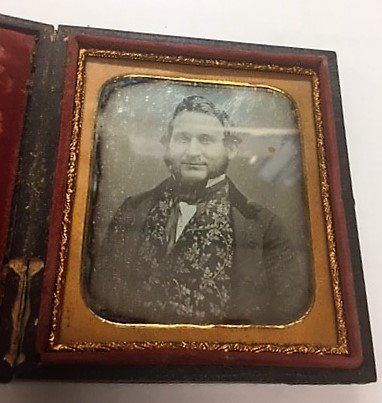Do you know how many pictures have been taken of you in your lifetime?
It’s a pretty tough question, especially considering the growing amount of photographs that we take each year. With the rise of cell phones, almost everyone has a camera in their pocket. One estimate says that we human beings will take a total of 1.3 trillion photographs in 2017 alone.
While today we might take one or two pictures each day, most people living in the mid-1800s would have had their picture taken once or twice in their entire lifetime.
It was only in the 1840s, with the use of the daguerreotype, that many people started to sit for photographs rather than painted portraits. Like painted works, these new portraits were highly valued and placed in expensive and elegant cases.

A daguerreotype from OHC’s collections.
The three main types of cased photographs include the daguerreotype, the ambrotype, and the tintype. There is a lot to learn about what makes each process unique. For more on that, please check out these resources: Fixed in Time, Graphics Atlas.
So say it’s 1865 and you’re an average Ohioan who would like to have some photographs of your family to display around the house. What are you going to do?
To begin with, you’re going to have to find a good photographer. Operating these complicated processes took some expensive equipment and experience to get it right. You couldn’t just take your picture at home.
Many photographers were set up in cities, so you could find the closest urban center and take your family to a studio there. Or maybe a traveling photographer was coming through town and he could take your photograph in his studio on wheels.
Either way, it’s time to make sure that every member of the family from youngest to oldest puts on their best clothes and combs their hair. You don’t get your picture taken very often, so visitors to the house are going to be seeing this one for a while. You want to look nice.
After spending hours getting ready, you spend a few minutes in front of the camera. It looks like the photographer has set up a nice outdoor scene as a backdrop.
You’ve opted for the newest option in the world of photography: tintypes. Tintypes are a bit faster, cheaper, and more durable than daguerreotypes or ambrotypes. You might have a few extra pictures taken to mail to your aunt and uncle who live on the other side of Ohio. (Learn more about tintypes on the History Blog, right here.)
You also opt for an add-on to your tintype package: hand coloring. Don’t be fooled, color photographs don’t exist just yet. But a talented photographer or artist can add just the right shade of pink to your cheeks to make your tintype really pop. (In the photograph above, the tablecloth and the child’s cheeks are colored pink.)
Before you leave the photographer’s studio, it’s time to choose a case for your new portrait. There’s a whole list of options you can mix and match to make your case unique.
One of the other things that could make your photograph different was the case pad. You can see a red,velvet case pad here with a geometric design. (Can you spot any other differences in the tintypes below?)
There are only so many options to choose from, but this gives everyone a chance to stand out.
Exhausted, you head home with your new family photographs in hand.
This may seem like a ridiculous process just for one photograph, especially when you could have taken a dozen selfies in the time it took you to read this blog post. But have you ever had your picture taken by a professional photographer?
If you’re in school, you probably had your yearbook photo taken this fall. Just like someone sitting for an early photograph, you probably wore fancy clothes and got to pick from a huge list of options when your parents ordered prints.
Even though we will take 1.3 trillion photographs this year, it seems like we still like to have some portraits done by the professionals.
Does this change how you think about antique photographs? Can you think of anything else that you do in 2017 that might be similar to something your ancestors did? Let us know in the comments!
Author’s Note: The tintypes that are featured at the end of this post depict unidentified members of the Hatfield Family of Warren County, Ohio. The very similar cases and backgrounds led me to believe that these may have all been purchased at one time.
When I photographed these tintypes to include in this blog post, my modern camera used its facial recognition system to place a floating yellow square over the faces of each portrait sitter. It seems like modern technology even recognizes people of the past!